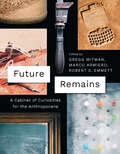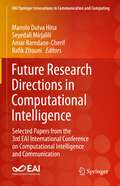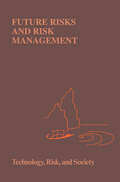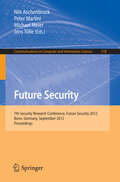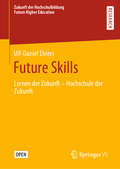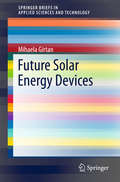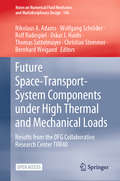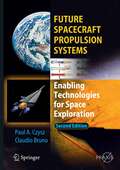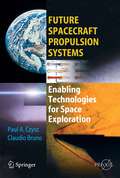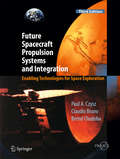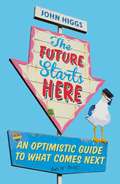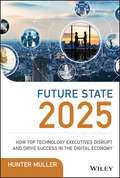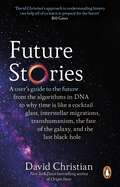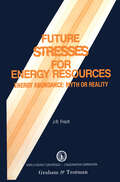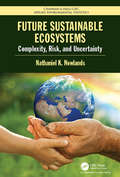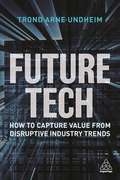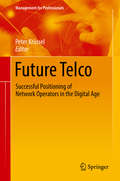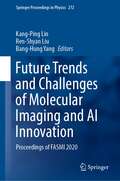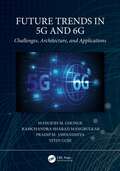- Table View
- List View
Future Remains: A Cabinet of Curiosities for the Anthropocene
by Gregg Mitman Marco Armiero Robert S. EmmettWhat can a pesticide pump, a jar full of sand, or an old calico print tell us about the Anthropocene—the age of humans? Just as paleontologists look to fossil remains to infer past conditions of life on earth, so might past and present-day objects offer clues to intertwined human and natural histories that shape our planetary futures. In this era of aggressive hydrocarbon extraction, extreme weather, and severe economic disparity, how might certain objects make visible the uneven interplay of economic, material, and social forces that shape relationships among human and nonhuman beings? Future Remains is a thoughtful and creative meditation on these questions. The fifteen objects gathered in this book resemble more the tarots of a fortuneteller than the archaeological finds of an expedition—they speak of planetary futures. Marco Armiero, Robert S. Emmett, and Gregg Mitman have assembled a cabinet of curiosities for the Anthropocene, bringing together a mix of lively essays, creatively chosen objects, and stunning photographs by acclaimed photographer Tim Flach. The result is a book that interrogates the origins, implications, and potential dangers of the Anthropocene and makes us wonder anew about what exactly human history is made of.
Future Remains: A Cabinet of Curiosities for the Anthropocene
by Gregg Mitman Marco Armiero Robert S. EmmettWhat can a pesticide pump, a jar full of sand, or an old calico print tell us about the Anthropocene—the age of humans? Just as paleontologists look to fossil remains to infer past conditions of life on earth, so might past and present-day objects offer clues to intertwined human and natural histories that shape our planetary futures. In this era of aggressive hydrocarbon extraction, extreme weather, and severe economic disparity, how might certain objects make visible the uneven interplay of economic, material, and social forces that shape relationships among human and nonhuman beings? Future Remains is a thoughtful and creative meditation on these questions. The fifteen objects gathered in this book resemble more the tarots of a fortuneteller than the archaeological finds of an expedition—they speak of planetary futures. Marco Armiero, Robert S. Emmett, and Gregg Mitman have assembled a cabinet of curiosities for the Anthropocene, bringing together a mix of lively essays, creatively chosen objects, and stunning photographs by acclaimed photographer Tim Flach. The result is a book that interrogates the origins, implications, and potential dangers of the Anthropocene and makes us wonder anew about what exactly human history is made of.
Future Remains: A Cabinet of Curiosities for the Anthropocene
by Gregg Mitman Marco Armiero Robert S. EmmettWhat can a pesticide pump, a jar full of sand, or an old calico print tell us about the Anthropocene—the age of humans? Just as paleontologists look to fossil remains to infer past conditions of life on earth, so might past and present-day objects offer clues to intertwined human and natural histories that shape our planetary futures. In this era of aggressive hydrocarbon extraction, extreme weather, and severe economic disparity, how might certain objects make visible the uneven interplay of economic, material, and social forces that shape relationships among human and nonhuman beings? Future Remains is a thoughtful and creative meditation on these questions. The fifteen objects gathered in this book resemble more the tarots of a fortuneteller than the archaeological finds of an expedition—they speak of planetary futures. Marco Armiero, Robert S. Emmett, and Gregg Mitman have assembled a cabinet of curiosities for the Anthropocene, bringing together a mix of lively essays, creatively chosen objects, and stunning photographs by acclaimed photographer Tim Flach. The result is a book that interrogates the origins, implications, and potential dangers of the Anthropocene and makes us wonder anew about what exactly human history is made of.
Future Remains: A Cabinet of Curiosities for the Anthropocene
What can a pesticide pump, a jar full of sand, or an old calico print tell us about the Anthropocene—the age of humans? Just as paleontologists look to fossil remains to infer past conditions of life on earth, so might past and present-day objects offer clues to intertwined human and natural histories that shape our planetary futures. In this era of aggressive hydrocarbon extraction, extreme weather, and severe economic disparity, how might certain objects make visible the uneven interplay of economic, material, and social forces that shape relationships among human and nonhuman beings? Future Remains is a thoughtful and creative meditation on these questions. The fifteen objects gathered in this book resemble more the tarots of a fortuneteller than the archaeological finds of an expedition—they speak of planetary futures. Marco Armiero, Robert S. Emmett, and Gregg Mitman have assembled a cabinet of curiosities for the Anthropocene, bringing together a mix of lively essays, creatively chosen objects, and stunning photographs by acclaimed photographer Tim Flach. The result is a book that interrogates the origins, implications, and potential dangers of the Anthropocene and makes us wonder anew about what exactly human history is made of.
Future Research Directions in Computational Intelligence: Selected Papers from the 3rd EAI International Conference on Computational Intelligence and Communication (EAI/Springer Innovations in Communication and Computing)
by Manolo Dulva Hina Seyedali Mirjalili Amar Ramdane-Cherif Rafik ZitouniThis book presents select papers from 3rd EAI International Conference on Computational Intelligence and Communications (CICom 2022). The papers reveal recent advances in the broader domains of Computational Intelligence including (1) automation, control, and intelligent transportation system, (2) big data, internet of things, and smart cities, (3) wireless communication systems and cyber security and (4) human/brain-computer interfaces, and image and pattern recognition. The book demonstrates complex real-world problems in which mathematical or traditional modellings are not the preferred solution, hence alternative solutions are needed. This collection of applications demonstrates the important advances in computational intelligence. The book chapters’ present various ideas that will benefit researchers, graduate students and engineers in this domain.
Future Risks and Risk Management (Risk, Governance and Society #9)
by Nils-EricSahlin BerndtBrehmerFuture Risks and Risk Management provides a broad perspective on risk, including basic philosophical issues concerned with values, psychological issues, such as the perception of risk, the factors that generate risks in current and future technological and social systems, including both technical and organizational factors. No other volume adopts this broad perspective. Future Risks and Risk Management will be useful in a variety of contexts, both for teaching and as a source book for the risk professional needing to be informed of the broader issues in the field.
Future Security: 7th Security Research Conference, Future Security 2012, Bonn, Germany, September 4-6, 2012. Proceedings (Communications in Computer and Information Science #318)
by Nils Aschenbruck Peter Martini Michael Meier Jens TölleThis book constitutes the refereed proceedings of the 7th Security Research Conference, Future Security 2012, held in Bonn, Germany, in September 2012. The 78 revised full papers presented were carefully reviewed and selected from 137 submissions. The papers are organized in topical sections on supply chain and critical infrastructure protection; security situational awareness; crisis management; security for critical infrastructure and urban areas; sensor technology; social, psychological and political aspects; cyber defense and information security; maritime and border security; detection of hazardous materials; food chain security; aviation security; ergonomic aspects.
Future Skills: Lernen der Zukunft - Hochschule der Zukunft (Zukunft der Hochschulbildung - Future Higher Education)
by Ulf-Daniel EhlersDieses Open Access-Buch analysiert veränderte Grundkoordinaten der Hochschulbildung weltweit und stellt die Frage, wie Hochschulbildung sich entwickeln muss, um in einer Welt globaler Herausforderungen, sich immer schneller wandelnden gesellschaftlichen Umbrüchen und innovationsgetriebenen, agilen Arbeitsfeldern bestehen können. Mit der NextSkills-Studie wird über ein qualitativ-quantitatives Multimethodendesign erstmals ein ganzheitliches bildungswissenschaftlich fundiertes Future Skills Konzept konstruiert und validiert. Future Skills und das ihnen zugrunde liegende Triple Helix Model zukünftiger Handlungsfähigkeit werden im Detail beschrieben. Das Buch führt die Diskussionsstränge um die Zukunft der Hochschule zusammen. Es beschreibt die 10 Sekunden zukünftiger Hochschulentwicklung und entwickelt vier Szenarien für die Hochschule der Zukunft.
Future Solar Energy Devices (SpringerBriefs in Applied Sciences and Technology)
by Mihaela GirtanThis book addresses electronics and the rise of photonics, and asks what the future holds in store for this technology. It highlights the latest research on all types of solar cells and photonic devices, and a new approach combining photonics and electronics. Beyond simply explaining the existing systems or providing a synthesis of the current state of knowledge, the book also offers readers new perspectives for their own research. Lastly, drawing on the interconnections between electronics and photonics, the book suggests a possible means of using solar energy directly with the aid of future photonic devices.
Future Space-Transport-System Components under High Thermal and Mechanical Loads: Results from the DFG Collaborative Research Center TRR40 (Notes on Numerical Fluid Mechanics and Multidisciplinary Design #146)
by Nikolaus A. Adams Wolfgang Schröder Rolf Radespiel Oskar J. Haidn Thomas Sattelmayer Christian Stemmer Bernhard WeigandThis open access book presents the findings of Collaborative Research Center Transregio 40 (TRR40), initiated in July 2008 and funded by the German Research Foundation (DFG). Gathering innovative design concepts for thrust chambers and nozzles, as well as cutting-edge methods of aft-body flow control and propulsion-component cooling, it brings together fundamental research undertaken at universities, testing carried out at the German Aerospace Center (DLR) and industrial developments from the ArianeGroup. With a particular focus on heat transfer analyses and novel cooling concepts for thermally highly loaded structures, the book highlights the aft-body flow of the space transportation system and its interaction with the nozzle flow, which are especially critical during the early phase of atmospheric ascent. Moreover, it describes virtual demonstrators for combustion chambers and nozzles, and discusses their industrial applicability. As such, it is a timely resource for researchers, graduate students and practitioners.
Future Spacecraft Propulsion Systems: Enabling Technologies for Space Exploration (Springer Praxis Books)
by Claudio Bruno Paul A. CzyszAn understandable perspective on the types of space propulsion systems necessary to enable low-cost space flights to Earth orbit and to the Moon and the future developments necessary for exploration of the solar system and beyond to the stars.
Future Spacecraft Propulsion Systems: Enabling Technologies for Space Exploration (Springer Praxis Bks.)
by Paul A. Czysz Claudio BrunoAn understandable perspective on the types of space propulsion systems necessary to enable low-cost space flights to Earth orbit and to the Moon and the future developments necessary for exploration of the solar system and beyond to the stars.
Future Spacecraft Propulsion Systems and Integration: Enabling Technologies for Space Exploration (Springer Praxis Books)
by Paul A. Czysz Claudio Bruno Bernd ChudobaThe updated and expanded third edition of this book focuses on the multi-disciplinary coupling between flight-vehicle hardware alternatives and enabling propulsion systems. It discusses how to match near-term and far-term aerospace vehicles to missions and provides a comprehensive overview of the subject, directly contributing to the next-generation space infrastructure, from space tourism to space exploration. This holistic treatment defines a mission portfolio addressing near-term to long-term space transportation needs covering sub-orbital, orbital and escape flight profiles. In this context, a vehicle configuration classification is introduced covering alternatives starting from the dawn of space access. A best-practice parametric sizing approach is introduced to correctly design the flight vehicle for the mission. This technique balances required mission with the available vehicle solution space and is an essential capability sought after by technology forecasters and strategic planners alike.
The Future Starts Here: Adventures in the Twenty-First Century
by John Higgs'The future hasn't happened yet. The idea that our civilisation is doomed is not established fact. It is a story we tell ourselves.'In the 1980s, we gave up on the future. When we look ahead now, we imagine economic collapse, environmental disaster and the zombie apocalypse. But what if we are wrong? What if this bleak outlook is a generational quirk that afflicted those raised in the twentieth century, but which is already beginning to pass? What if we do have a future after all?John Higgs takes us on a journey past the technological hype and headlines to discover why we shouldn't trust the predictions of science fiction, why nature is not as helpless as we assume and why purpose can never be automated. In the process, we will come to a better understanding of what lies ahead and how, despite everything - despite all the horrors and instability we face - we can build a better future.
Future State 2025: How Top Technology Executives Disrupt and Drive Success in the Digital Economy
by Hunter MullerIdentify the best technology investments and implement them rapidly Accelerating Innovation and Invention in the 21st Century Enterprise: How Top CIOs Leverage Technology to Achieve Superior Results gives CIOs an essential playbook for learning how to implement and sustain innovation and invention. Drawing on the experiences of many of the world’s leading CIOs, the book reveals the strategies and techniques they used to put in place the newest techniques and technologies. Since the rise of the digital economy, the role of the CIO has expanded the responsibilities of the IT team function. The new norm is continuous innovation; CIOs must deliver or perish. This book offers a guide for selecting and implementing the right technology that is so essential for success in the hyper-competitive marketplace. This vital resource offers a guide to tech investments including: • Artificial Intelligence and advanced cyber security • Robotics and advanced networks including Mesh, Edge and Hybrid Cloud • Virtual Reality and smart cities • Autonomous transportation, logistics and rapid prototyping, and digital twin Accelerating Innovation and Invention in the 21st Century Enterprise is written to help identify the best technology investments and move forward with rapid implementations of new tech and stay ahead of the competition.
Future State 2025: How Top Technology Executives Disrupt and Drive Success in the Digital Economy
by Hunter MullerIdentify the best technology investments and implement them rapidly Accelerating Innovation and Invention in the 21st Century Enterprise: How Top CIOs Leverage Technology to Achieve Superior Results gives CIOs an essential playbook for learning how to implement and sustain innovation and invention. Drawing on the experiences of many of the world’s leading CIOs, the book reveals the strategies and techniques they used to put in place the newest techniques and technologies. Since the rise of the digital economy, the role of the CIO has expanded the responsibilities of the IT team function. The new norm is continuous innovation; CIOs must deliver or perish. This book offers a guide for selecting and implementing the right technology that is so essential for success in the hyper-competitive marketplace. This vital resource offers a guide to tech investments including: • Artificial Intelligence and advanced cyber security • Robotics and advanced networks including Mesh, Edge and Hybrid Cloud • Virtual Reality and smart cities • Autonomous transportation, logistics and rapid prototyping, and digital twin Accelerating Innovation and Invention in the 21st Century Enterprise is written to help identify the best technology investments and move forward with rapid implementations of new tech and stay ahead of the competition.
Future Stories: A user's guide to the future
by David Christian'David Christian's approach to understanding history can help all of us learn to prepare for the future' - Bill GatesA user's guide to the future: from the algorithms in DNA to why time is like a cocktail glass, interstellar migrations, transhumanism, the fate of the galaxy, and the last black hole...Every second of our lives - whether we're looking both ways before crossing the street, celebrating the birth of a baby, or moving to a new city - we must cope with an unknowable future by telling stories about what will happen next. Where is the future, the place where we set those stories? Can we trust our future stories? And what sort of futures do they show us?David Christian, historian and bestselling author of Origin Story, is renowned for pioneering the emerging discipline of Big History, which surveys the whole of the past. But with Future Stories, he casts his sharp analytical eye forward, offering an introduction to the strange world of the future, and a guide to what we think we know about it at all scales, from the predictive mechanisms of single-celled organisms and tomato plants to the merging of colossal galaxies billions of years from now.Drawing together science, history and philosophy from a huge range of places and times, Christian explores how we prepare for uncertain futures, including the future of human evolution, artificial intelligence, interstellar travel, and more. By linking the study of the past much more closely to the study of the future, we can begin to imagine what the world will look like in the next hundred years and consider solutions to the biggest challenges facing us all.
Future Stresses for Energy Resources: Energy Abundance: Myth or Reality?
by Jean-Romain FrischFrom its very beginnings, the Conservation Commission has devoted a large part of its research to long-term energy analyses. Following the first oil shock, it undertook its earliest work on the world demand-supply equilib rium for the period 2000-2020, the results of which were presented to the 10th Congress of the Conference at Istanbul in 1977. Since then, its analyses have become ever deeper, ever more various. In 1980, the stress was on the future for the Third World, while in 1983, its forecasts set out a new panorama for the world and for the main regions in the period 2000-2020. Therefore, what was more natural than that the Conservation Commission should bring its interest to bear on one of the major aspects of energy strategy: the comparison of future needs not merely with the fluctuations of supply but also with stocks of reserves. The problem, of course, had not been entirely ignored, but the field tended to be one in which intuitions and sketchy proofs were more readily available than systematic and comprehen sive analysis.
Future Sustainable Ecosystems: Complexity, Risk, and Uncertainty (Chapman & Hall/CRC Applied Environmental Statistics)
by Nathaniel K NewlandsFuture Sustainable Ecosystems: Complexity, Risk, Uncertainty provides an interdisciplinary, integrative overview of environmental problem-solving using statistics. It shows how statistics can be used to solve diverse environmental and socio-economic problems involving food, water, energy scarcity, and climate change risks. It synthesizes interdisciplinary theory, concepts, definitions, models and findings involved in complex global sustainability problem-solving, making it an essential guide and reference. It includes real-world examples and applications making the book accessible to a broader interdisciplinary readership. Discussions include a broad, integrated perspective on sustainability, integrated risk, multi-scale changes and impacts taking place within ecosystems worldwide. State-of-the-art statistical techniques, including Bayesian hierarchical, spatio-temporal, agent-based and game-theoretic approaches are explored. The author then focuses on the real-world integration of observational and experimental data and its use within statistical models.
Future Sustainable Ecosystems: Complexity, Risk, and Uncertainty (Chapman & Hall/CRC Applied Environmental Statistics)
by Nathaniel K NewlandsFuture Sustainable Ecosystems: Complexity, Risk, Uncertainty provides an interdisciplinary, integrative overview of environmental problem-solving using statistics. It shows how statistics can be used to solve diverse environmental and socio-economic problems involving food, water, energy scarcity, and climate change risks. It synthesizes interdisciplinary theory, concepts, definitions, models and findings involved in complex global sustainability problem-solving, making it an essential guide and reference. It includes real-world examples and applications making the book accessible to a broader interdisciplinary readership. Discussions include a broad, integrated perspective on sustainability, integrated risk, multi-scale changes and impacts taking place within ecosystems worldwide. State-of-the-art statistical techniques, including Bayesian hierarchical, spatio-temporal, agent-based and game-theoretic approaches are explored. The author then focuses on the real-world integration of observational and experimental data and its use within statistical models.
Future Tech: How to Capture Value from Disruptive Industry Trends
by Trond Arne UndheimAmazon's Fire phone. Google Glass. Facebook Home. Quikster. New technologies alone don't always cause industry changes. Future Tech explains how the four forces of technology, policy, business models and social dynamics work together to create industry disruption and how this understanding can help to predict what is coming next. Technology is generally viewed as the single force that disrupts markets. However, history is rife with stories of technologies that have failed to meet such hyped expectations. In Future Tech, the author reveals that true change only results from combining the forces of science and technology, policy and regulation, new business models (i.e. sharing economy) and social dynamics (whether or not people adopt it). Whether these four forces align explains why some technologies, such as AI, blockchain, robotics, synthetic biology and 3D printing, stick and why others fail. With an understanding of these four forces, business executives and policymakers can explain what technology is likely to stick and even anticipate what is coming next.By 2030, the global labor force will be led by an elite set of knowledge workers enabled by robotic AI. To help individuals thrive in this workplace, Future Tech advises readers to develop their human capabilities of creativity and adaptation, develop deep expertise in one domain while being well-versed in dozens more, and develop a personalized approach to acquiring and processing information and deliberating decisions.
Future Telco: Successful Positioning of Network Operators in the Digital Age (Management for Professionals)
by Peter KrüsselThis book examines the extensive changes in markets, technologies and value chains that telecommunication companies are currently confronted with. It analyzes the crossroads they have reached and the choices that now need to be made – to be a bit pipe or a trendsetter of digitalization. Based on an analysis of the key challenges for telcos, the book derives future market scenarios and puts forward recommendations for how they can successfully position themselves. It proposes a framework based on seven “levers,” which addresses concrete measures in each step of the value chain, ranging from technology, IT and processes, to innovation, marketing and sales issues. The book discusses the current challenges and provides both general recommendations and concrete solutions. Respected experts illustrate innovative strategic and technical trends and provide insights gained in real-life transformation projects. Recent developments in the areas of regulation, product development, competition between over-the-top (OTT) providers and telcos, as well as technical innovations like 5G, SDN/NFV, LEO satellites and MEC are discussed. Accordingly, practitioners, managers and researchers alike will benefit from the book’s wealth of examples and up-to-date insights.
Future Trends and Challenges of Molecular Imaging and AI Innovation: Proceedings of FASMI 2020 (Springer Proceedings in Physics #272)
by Kang-Ping Lin Ren-Shyan Liu Bang-Hung YangThis volumes presents the proceedings of the FASMI 2020 conference, held at Taipei Veterans General Hospital on November 20-22, 2020. It presents contributions on all aspects of molecular imaging, discovered by leading academic scientists and researchers. It also provides a premier interdisciplinary treatment of recent innovations, trend, and concerns as well as practical challenges and solutions in Molecular Imaging and put an emphasis on Artificial Intelligence applied to Imaging Data. FASMI is the annual meeting of the Federation of Asian Societies for Molecular Imaging
Future Trends in 5G and 6G: Challenges, Architecture, and Applications
by Mangesh Ghonge Ramchandra Sharad Mangrulkar Pradip M Jawandhiya Nitin GojeFuture Trends in 5G and 6G: Challenges, Architecture, and Applications offers a comprehensive overview of basic communication and networking technologies. It focuses on emerging technologies, such as Software-Defined Network (SDN)-based ad hoc networks, 5G, Machine Learning, and Deep Learning solutions for communication and networking, Cloud Computing, etc. It also includes discussions on practical and innovative applications, including Network Security, Smart Cities, e-health, and Intelligent Systems. The book addresses several key issues in SDN energy-efficient systems, the Internet of Things, Big Data, Cloud Computing and Virtualization, Machine Learning, Deep Learning, Cryptography, and 6G wireless technology and its future. It provides students, researchers, and practicing engineers with an expert guide to the fundamental concepts, challenges, architecture, applications, and state-of-the-art developments in communication and networking.
Future Trends in 5G and 6G: Challenges, Architecture, and Applications
by Mangesh Ghonge Ramchandra Sharad Mangrulkar Pradip M Jawandhiya Nitin GojeFuture Trends in 5G and 6G: Challenges, Architecture, and Applications offers a comprehensive overview of basic communication and networking technologies. It focuses on emerging technologies, such as Software-Defined Network (SDN)-based ad hoc networks, 5G, Machine Learning, and Deep Learning solutions for communication and networking, Cloud Computing, etc. It also includes discussions on practical and innovative applications, including Network Security, Smart Cities, e-health, and Intelligent Systems. The book addresses several key issues in SDN energy-efficient systems, the Internet of Things, Big Data, Cloud Computing and Virtualization, Machine Learning, Deep Learning, Cryptography, and 6G wireless technology and its future. It provides students, researchers, and practicing engineers with an expert guide to the fundamental concepts, challenges, architecture, applications, and state-of-the-art developments in communication and networking.
